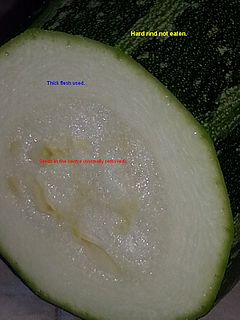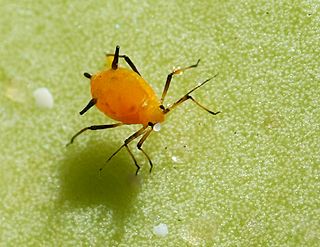
Cucurbita is a genus of herbaceous vines in the gourd family, Cucurbitaceae native to the Andes and Mesoamerica. Five species are grown worldwide for their edible fruit, variously known as squash, pumpkin, or gourd, depending on species, variety, and local parlance, and for their seeds. Other kinds of gourd, also called bottle-gourds, are native to Africa and belong to the genus Lagenaria, which is in the same family and subfamily as Cucurbita, but in a different tribe. These other gourds are used as utensils or vessels, and their young fruits are eaten much like those of Cucurbita species.

The zucchini, courgette or baby marrow is a summer squash, a herbaceous vine whose fruit are harvested when their immature seeds and epicarp (rind) are still soft and edible. It is closely related, but not identical, to the marrow; its fruit may be called marrow when mature.

A marrow is a vegetable, the mature fruit of certain Cucurbita pepo cultivars. The immature fruit of the same or similar cultivars is called courgette or zucchini. Like courgettes, marrows are oblong, green squash, but marrows have a firm rind and a neutral flavour, making them useful as edible casings for mincemeat and other stuffings. They can be stored for several weeks after harvest, to be processed for food when required. They are a vegetable used in Great Britain and areas with significant British influence, though their popularity is waning in favor of immature summer squash like courgette.

Plum pox, also known as sharka, is the most devastating viral disease of stone fruit from the genus Prunus. The disease is caused by the plum pox virus (PPV), and the different strains may infect a variety of stone fruit species including peaches, apricots, plums, nectarine, almonds, and sweet and tart cherries. Wild and ornamental species of Prunus may also become infected by some strains of the virus.

Lettuce mosaic virus (LMV) is a typical potyvirus, which causes one of the major virus diseases of lettuce crops worldwide.

Potyvirus is a genus of viruses in the family Potyviridae. Plants serve as natural hosts. There are currently 183 species in this genus including the type species Potato virus Y. The genus is named after the type virus. Potyviruses account for ~30% of the currently known plant viruses. Like begomoviruses, members of this genus may cause significant losses in agricultural, pastoral, horticultural and ornamental crops. More than 200 species of aphids spread potyviruses and most are from the subfamily Aphidinae.

Papaya ringspot virus (PRSV) is a pathogenic plant virus in the genus Potyvirus and the virus family Potyviridae which primarily infects the papaya tree.
Bean yellow mosaic virus is a plant pathogenic virus in the genus Potyvirus and the virus family Potyviridae. Like other members of the Potyvirus genus, it is a monopartite strand of positive-sense, single-stranded RNA surrounded by a capsid made for a single viral encoded protein. The virus is a filamentous particle that measures about 750 nm in length. This virus is transmitted by species of aphids and by mechanical inoculation.

Cucumber mosaic virus (CMV) is a plant pathogenic virus in the family Bromoviridae. It is the type member of the plant virus genus, Cucumovirus. This virus has a worldwide distribution and a very wide host range. In fact it has the reputation of having the widest host range of any known plant virus. It can be transmitted from plant to plant both mechanically by sap and by aphids in a stylet-borne fashion. It can also be transmitted in seeds and by the parasitic weeds, Cuscuta sp. (dodder).
Panicum mosaic virus (PMV) is a positive-sense single-stranded RNA viral pathogen that infects plant species in the panicoid tribe of the grass family, Poaceae. The pathogen was first identified in Kansas in 1953 and most commonly causes disease on select cultivars of turf grass, switchgrass, and millet. The disease most commonly associated with the panicum mosaic virus pathogen is St. Augustine Decline Syndrome, which infects species of turf grass and causes chlorotic mottling. In addition to St. Augustine Decline, panicum mosaic virus is responsible for chlorotic streaking and mild green mosaicking in select cultivars of switchgrass and millet.
Peanut stunt virus (PSV) is a plant pathogenic virus in the family Bromoviridae. It is a member of the genus Cucumovirus , the type member of which is Cucumber mosaic virus. The three members of this genus are positive-stranded RNA viruses with a multipartite genome. The virus particles have an isometric or spherical shape.
Potato virus Y (PVY) is a plant pathogenic virus of the family Potyviridae, and one of the most important plant viruses affecting potato production.
Soybean mosaic virus (SMV) is a member of the plant virus genus Potyvirus. It infects mainly plants belonging to the family Fabaceae but has also been found infecting other economically important crops. SMV is the cause of soybean mosaic disease that occurs in all the soybean productions areas of the world. Soybean is one of the most important sources of edible oil and proteins and pathogenic infections are responsible for annual yield losses of about $4 billion in the United States. Among these pathogens, SMV is the most important and prevalent viral pathogen in soybean production worldwide. It causes yield reductions of about 8% to 35% but losses as high as 94% have been reported.

Tulip breaking virus is one of five plant viruses of the family Potyviridae that cause color-breaking of tulip flowers. These viruses infect plants in only two genera of the family Liliaceae: tulips (Tulipa) and lilies (Lilium).
Commelina mosaic virus (CoMV) is a plant pathogenic virus in the genus Potyvirus and the virus family Potyviridae. Like other members of the Potyvirus genus, CoMV is a monopartite strand of positive-sense, single-stranded RNA surrounded by a capsid made for a single viral encoded protein. The virus is a filamentous particle that measures about 707-808 nm in length. This virus is transmitted by two species of aphids, Myzus persicae and Aphis gossypii, and by mechanical inoculation.

Watermelon mosaic virus (WMV) also known as Marrow mosaic virus, Melon mosaic virus, and until recently Watermelon mosaic virus type 2 (WMV-2), is a plant pathogenic virus that causes viral infection in many different plants. First described on squash in Florida, WMV arose from a unique recombination of genetic material contributed by Soybean mosaic virus (SMV) and Bean common mosaic virus (BCMV) along with Peanut Stripe virus (PSV).

Squash mosaic virus (SqMV) is a mosaic virus disease common in squash plants and other plants, including melons, of the family Cucurbitaceae. It occurs worldwide. It is transmitted primarily by beetles, including the leaf beetle, spotted cucumber beetle, and 28-spotted ladybird beetle, as well as some other beetles. Plants are infected by the saliva expelled by the beetles as they feed upon the plant. The beetles acquire the virus by feeding upon an infected plant and can retain the virus in their bodies for up to 20 days. Unlike some other mosaic viruses that infect squashes, SqMV is not spread by aphids. In melons it can be spread by seeds. The results are dark green mosaic, blistering, vein clearing, yellowing of leaves, and hardening. Symptoms include "pronounced chlorotic mottle, green veinbanding, and distortion of leaves". Fruits of infected plants are also affected, becoming mottled and misshaped. There are two strains of this virus: strain 1 has a greater effect on melons than squash while the opposite is true of strain 2.

Aphis nerii is an aphid of the family Aphididae. Its common names include oleander aphid, milkweed aphid, sweet pepper aphid, and nerium aphid.

Melon necrotic spot virus (MNSV) is a virus that belongs to the genus Carmovirus of the family Tombusviridae. It has been observed in several countries of the Americas, Africa, Asia, and Europe. It is considered to be an endemic virus in greenhouses and field productions of Cucurbitaceae crops, including melon, cucumber, and watermelon. MNSV is mainly spread through infected soil, seedlings, insects, and by the root-inhabiting fungus vector Olpidium bornovanus. Symptoms vary between Curbitaceae crops, but generally consist of chlorosis, brown necrotic lesions, leaf wilt, fruit decay, and plant death. Management of the disease consists of preventing infection by rotating fields and crops, steam sterilization, and disposal of infected plants. Also, treated seeds with heat or chemicals are efficient in preventing infection. MNSV is important in melon plants as it causes vast economical damage worldwide reducing significant yields.
Carrot virus Y (CarVY) is a (+)ss-RNA virus that affects crops of the carrot family (Apiaceae), such as carrots, anise, chervil, coriander, cumin, dill and parsnip. Carrots are the only known crop to be infected in the field. Infection by the virus leads to deformed roots and discolored or mottled leaves. The virus is spread through insect vectors, and is currently only found in Australia.












